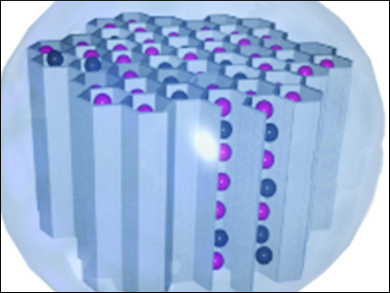Nanoscale capsules used in drug delivery systems are loaded with useful guest molecules, which may, however, cause side effects if released prematurely. The delivery of such a payload can be achieved, for example, by a photoactivated transformation.
Chiyoung Park, Korea Institute of Science and Technology (KIST), Jeonbuk, South Korea, and colleagues have prepared mesoporous silica nanocarriers (pictured) loaded with both guest molecules and photoacid generators (PAGs). Pores on the outer surface of the nanoparticles are blocked with copper(II) complexes coordinated by tannic acid ligands. Under UV light, the PAGs release protons that activate confined dye guest molecules and simultaneously degrade the coordination complex responsible for confinement and, thus, trigger the release of the payload.
The team prepared hybrid assemblies of the copper nanocapsules, e.g., as a thin film on glass or in combination with a PVA hydrogel. Dye release from these systems was only achieved after UV light activation. This phototriggered release of active guests from robust silica capsules is relevant to drug delivery and self-healing applications.
- Signal-Induced Release of Guests from a Photolatent Metal-Phenolic Supramolecular Cage and Its Hybrid Assemblies,
Chiyoung Park, Beom Joo Yang, Ki Beom Jeong, Chae Bin Kim, Seunghyun Lee, Bon-Cheol Ku,
Angew. Chem. Int. Ed. 2017.
DOI: 10.1002/anie.201701152




